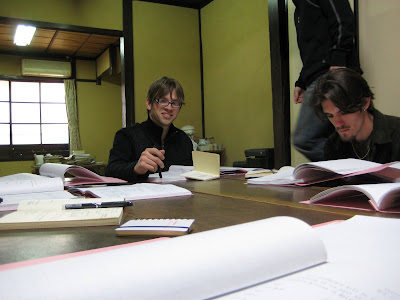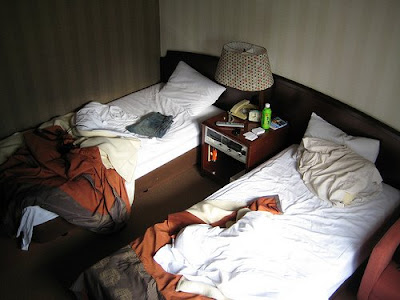Japan is everything I could have hoped for and more.
Although I have only been here for 2 days, the experiences have made it feel much longer. I attribute this to the fact that everything I am seeing is entirely unfamiliar. Each of our activities, like walking around town, exploring a mini mall, or even buying goods at a convenience store, have been completely redefined to the smallest detail. Amenities like drink vending machines (which are literally everywhere) present a variety of intriguing possibilities. It's often hard to make a decision, as everything looks so interesting. This is echoed throughout the organization of the city of Kyoto. There are so many streets and alleyways that it would be utterly impossible to venture through them all, yet the appeal to do so strong. At night, public spaces transform into a play of colorful lights, sounds, and excitement. There is seemingly no end to it all, and I often feel as though I am embedded in an infinite maze.
The Japanese truly value the small amount of space that they possess. In the mornings, Shop owners are sweeping and scrubbing the storefronts. Trash is picked up daily, and it is nearly impossible to find a loose piece of waste on the ground. It's amazing how immaculate the streets are. Green spaces are rare, yet their occurrence is never overlooked. There are quite a few waterways that flow through the city, each of which are lined with grass and trees, presenting the opportunity for one lane of traffic (including cars, bikes, and pedestrians) to travel alongside. It's really quite beautiful.
There are some funny things...
Cars are awesome, yet it is still somewhat entertaining to see that most of what people drive are in a miniaturized form. The squished vans are the most notable of these, where the body appears compressed from the front, back, and sides, causing it to appear stretched vertically. The front end is literally a foot beyond where the driver sits. I have conceded that I want to take one home, but that would never fly in the U.S. (Not to mention the fact that the driver sits on the right side).
Our hotel room is tiny, yet big enough for the two of us that are living in them for the next two weeks. The bathroom was literally a capsulated module that was plugged in. It's all very tiny, and I find myself bumping into things whenever I take a shower. What's more, when you step up into the room (about a six inch rise) your head is 6 inches from the ceiling. When you're in the shower/bath, you are practically touching it.
Television is amusing, although we can't understand any of it. The commercials are really the best part, all of which are completely random. I cannot do it justice by explaining, but most attempts at watching involve laughter, and I'm not sure whether it's intentional or not. It is, in one word, quirky.
We walked around much of kyoto today, and found that our hotel is very close to many of the amenities that we will be using. There is also a great deal of shopping and a public market only a few blocks away. In addition to exploring, we got to meet with our language professor today, who will be instructing us for the next four weeks. Our classroom is located in a very small, traditional japanese house that is crammed in between the neighboring buildings, a common theme that runs throughout the urban fabric of the dense Japanese city. It is about as authentic as you can get, with tatami mat floors through most of the interior.
After meeting our language professor, we went to the Nishiki Market, a narrow public marketplace that offers goods and exotic foods. For those new to the area, it would be nearly impossible to stumble upon, as there is very little exposure to the public environment. We got there by walking down a typical one-way street, where the only clue of its existence was a subtle overhang.
Turning the corner revealed a long expanse of colors, food displays, and crowds of people.
We tried a couple unusual items, including takoyaki, which is prepared by embedding a piece of squid into batter, and cooking it briefly over a tray of half-spherical molds. The results are round balls that are just strong enough to hold the hot batter and squid on the inside. They were delicious.
Tomorrow we will be taking a tour of Osaka (where we initially landed), which is about a half hour train ride from our hotel. It is very exciting that there is so much for us to do, and this is just the beginning. It's very surreal being here, and I don't think that feeling is going to cease at all.
I am thankful to all who have supported me in this trip. Hopefully, I will be able to share my experiences often. I hope you enjoy reading.



































